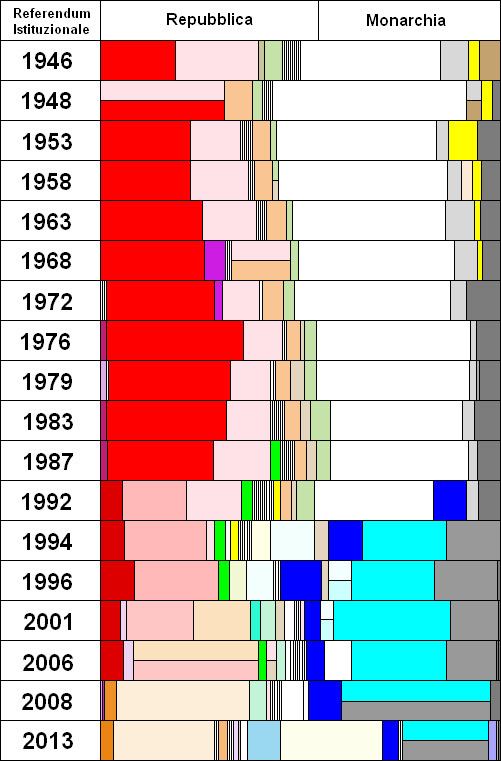 | ||
Italy elects, at the national level, a Parliament consisting of two houses: the Chamber of Deputies (Camera dei Deputati) with 630 members; and the Senate of the Republic (Senato della Repubblica) with 315 elected members, plus a few senators for life. The President of the Republic is elected for a seven-year term by the two houses of Parliament in joint session.
Contents
Italy has historically had many political parties, both national and regional, with different party systems.
The most recent Italian general election was held on 24 and 25 February 2013.
2013 election
A snap general election was held in Italy on 24 and 25 February 2013, after President Giorgio Napolitano dissolved parliament few months before, due to the resignation of the Prime Minister Mario Monti and his technocratic government. No absolute winner emerged from the election; the votes were divided into three parts: the centre-left alliance, Italy Common Good, whose major party was the Democratic Party, led by Pier Luigi Bersani, the Centre-right coalition, led by Silvio Berlusconi with his People of Freedom party, and the anti-establishment Five Star Movement, whose leader was Beppe Grillo. On 24 April 2013, Napolitano, gave the task to form a new government to the Deputy-Secretary of the Democratic Party, Enrico Letta. On 28 April he sworn in as Prime Minister.
Voter Turnout
According to an article written in Bloomberg news, voters are tired of the candidates, that is why voter turnout has been drastically reduced since the 1970s, along with the fact that there is no longer a compulsory voting system. The voter turnout in 2013 explains how the people of Italy really feel about the instability of their government.
Graph of general election results
This graph shows the results of elections held in Italy from 1946 to today, with the percentages of consensus gathered by the various parties and movements displayed by color. Passing your mouse over the different colored sections will display the name of the grouping and the percentage in the corresponding election. Clicking on a region will direct you to the article on the party or election selected.
Referendums
The constitution of Italy provides for two kinds of binding referendums.
A legislative referendum can be called in order to abrogate a law totally or partially, if requested by 500,000 electors or five regional councils. This kind of referendum is valid only if at least a majority of electors goes to the polling station. It is forbidden to call a referendum regarding financial laws or laws relating to pardons or the ratification of international treaties.
A constitutional referendum can be called in order to approve a constitutional law or amendment only when it has been approved by the Houses (Chamber of Deputies and Senate of the Republic) with a majority of less than two thirds in both or either House, and only at the request of one fifth of the members of either House, or 500,000 electors or five Regional Councils. A constitutional referendum is valid no matter how many electors go to the polling station. Any citizen entitled to vote in an election to the Chamber of Deputies may participate in a referendum.
